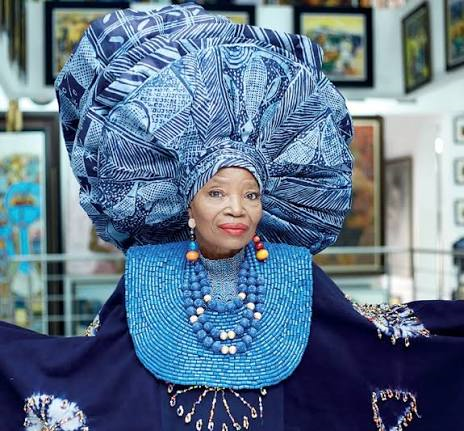Two weeks ago, the United States Government, through the Pennsylvania House of Representatives and Senate, honoured renowned African art icon Chief Nike Okundaye of Nike Art Gallery Lagos for her contributions to art in Nigeria and globally.
Okundaye was honoured for her revolutionary impact on contemporary African art, and recognised for being the pioneer of the Adire resist-dyeing technique, which has seamlessly blended ancestral motifs with modern aesthetics, earning global acclaim, thereby solidifying her legacy as a custodian of African heritage.
The honour was bestowed on her at the unveiling of the African Cultural Festival, 2025 held at the Pennsylvania State Capitol, while the festival will take place from September 19 to 20, 2025, in Pennsylvania.
She was honoured for giving hope to marginalised women, training and equipping over 5,000 women with Adire-making, weaving, and traditional craft skills.
“Her mission to foster economic independence and cultural continuity has empowered communities across Nigeria and beyond, ensuring that African artistry thrives in future generations,” the House and the Senate stated.
Information in the media space revealed that the upcoming festival was designed to celebrate African heritage, foster international collaboration, and stimulate trade and cultural exchange between Africa, the United States, and the world.
In addition, the festival is expected to solidify Africa’s cultural influence while creating pathways for sustainable growth and artistic innovation.
Part of activities lined up for the festival includes the launching of Duduplugs, an innovative digital platform by ACI234 Entertainment LLC, designed to connect creative industries across continents, and elevate Africa’s creative economy.
For those who may not know who this Icon of African Art is, Nike Okundaye was born May 23, 1951 in Ogidi, Kogi State and was brought up amidst the Yoruba traditional weaving and dyeing culture as practiced in her home town.
Her parents and great grandmother were musicians and craftspeople, who specialized in the areas of cloth weaving, Adire-making, indigo dyeing and leather. Early in life, she learned how to use the loom to produce cloth during the time she lived with her great grandmother Ibitola (“Red Woman”).
She spent part of her early life in Osogbo, present-day Osun State. Growing up in Osogbo, which is recognized as a major centre for art and culture in Nigeria, young Nike was exposed to the indigo dyeing and Adire production that dominated her informal training.
Over the past 20 years, she has conducted workshops on traditional Nigerian textiles for audiences in the United States and Europe, and had her first solo exhibition at the Goethe Institute, Lagos in 1968.
She is the founder and director of four art centres that offer free training to more than 150 young artists in visual, musical and performing arts, comprising more than 7,000 artworks.
Finding that the traditional methods of weaving and dyeing that had been her original inspiration were fading in Nigeria, she set about launching a revival of this aspect of Nigerian culture, building art centres offering free courses for young Nigerians to learn traditional arts and crafts.
As art historian John Peffer states, “One thing shared by many of the latest generation of African artists in the diaspora – those who have been successful on the art circuit – is that their work critiques the very burden of representation that is also the condition of their visibility.”
In her view, the traditional art of Adire Eleko is only possible because of a specific Nigerian heritage of passing knowledge from one generation to the next. In a video interview published by Nubia Africa, some years ago, Okundaye states that “schools can only teach what they (art students) already know.”
According to a CNBC Africa interview, she trained more than 3,000 young Nigerians for free and she continues to help by funding many poor to establish their small businesses and art workshops in different parts of Nigeria.
Her Adire and Batik textiles use visual themes taken from Yoruba history and mythology, as well as visual themes inspired by her own life experiences and dreams.
Information has it that she strives to improve lives of disadvantaged women in Nigeria through art, as she teaches the unique techniques of indigo cloth-dyeing (Adire) to rural women at her workshop in South-West Nigeria, and she hopes to revive the centuries-old tradition and the lives of these women.
She has been featured on CNN International’s African Voices, which features Africa’s most engaging personalities, exploring their lives and passions. Her painting is permanently displayed at the Smithsonian Museum as of 2012, and her work is also part of the collection of the Gallery of African Art and the British Library in London and at Johfrim Art and Design Studio.
She holds the chieftaincy titles of the Yeye Oba of Ogidi-Ijumu and the Yeye Tasase of Oshogbo.


